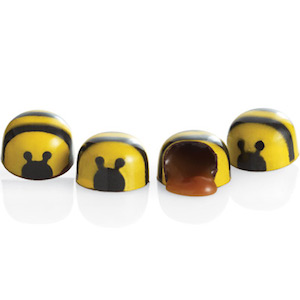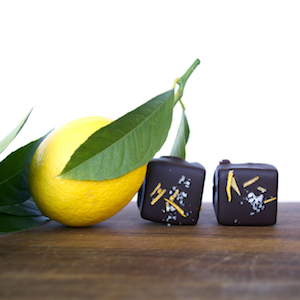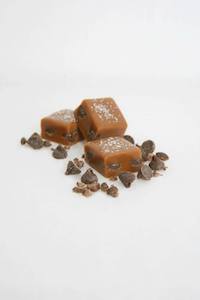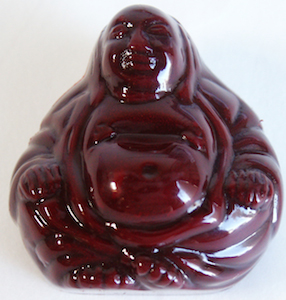Special Feature: Products Sally Recommends
chocolate, salt, and caramel: the ubiquitous trio
Some time ago, I wrote an article on the increasing use of chocolate and salt in the same food. The practice of using those two ingredients together has since become far more widespread, especially when caramel is added. In fact, I am beginning to wonder if it is still legal to produce a chocolate-covered caramel that does not contain detectable salt within the boundaries of the United States. You can find such caramels, but they are close to becoming an endangered species. Salt is added to a caramel recipe to a level where it's noticeable in the end product or sprinkled atop the chocolate covering (or both). I've even seen more than one type of salt used in one confection.
I n the first article I wrote about chocolate and salt, I mentioned the Lavender Caramel made by Lillie Belle Farms---a caramel infused with lavender, covered in chocolate, and topped with a pinch of fleur de sel. Not only is this caramel still being made, but proprietor Jeff Shepherd tells me it's his best selling confection, impressive considering that Lillie Belle has a lengthy roster of chocolate treats. He also makes a Cayenne Caramel. I know a lot of hot pepper lovers, and I'd have guessed that the Cayenne Caramel would be almost as popular. But the Lavender Caramel outsells the Cayenne Caramel by a factor of roughly one hundred to one, according to Jeff. (Full disclosure: Jeff was kind enough to send me some of his Lavender Caramels for this article. But even if he had not, I would have mentioned them anyway.)
n the first article I wrote about chocolate and salt, I mentioned the Lavender Caramel made by Lillie Belle Farms---a caramel infused with lavender, covered in chocolate, and topped with a pinch of fleur de sel. Not only is this caramel still being made, but proprietor Jeff Shepherd tells me it's his best selling confection, impressive considering that Lillie Belle has a lengthy roster of chocolate treats. He also makes a Cayenne Caramel. I know a lot of hot pepper lovers, and I'd have guessed that the Cayenne Caramel would be almost as popular. But the Lavender Caramel outsells the Cayenne Caramel by a factor of roughly one hundred to one, according to Jeff. (Full disclosure: Jeff was kind enough to send me some of his Lavender Caramels for this article. But even if he had not, I would have mentioned them anyway.)
Shepherd's chocolate-covered salt caramels have competitors everywhere. California's Chocolats du CaliBressan has a soft salted caramel in a dark chocolate shell shaped like the Buddha (you are urged to “lick his belly for good luck”) and a salted balsamic vinegar caramel in a dark chocolate shell. The former is their best-selling piece out of a roster of almost forty chocolates. Black Dinah Chocolatiers in Maine makes a chocolate-covered salt caramel with sea salt from their home state. In Pennsylvania, John and Kira's offers dark chocolate “bees” (molded chocolates in the shape of a hemisphere and painted with edible colors to resemble stylized bees) that contain a liquid caramel, lightly salted. Becky's Blissful Bakery in Wisconsin puts their own spin on this confection; bottom and top layers of caramel enclose a middle layer of dark chocolate chips, with a dusting of sea salt atop. New Jersey's Chocodiem sells a soft salt caramel enclosed in a dark chocolate shell shaped almost like a pyramid, except with a more rounded top.
Producers of chocolate bars have taken notice of the trio's popularity. Salazon Chocolate Co., whose slogan is “Salted. Organic. Dark.” now produces an organic dark chocolate bar with “just a touch of 100% organic caramel”, sprinkled with a bit of sea salt. Xocolatl de David has created a dark chocolate bar with salted caramel, a dark chocolate Bacon Caramel bar (of course that counts as chocolate, salt, and caramel; think about the salt content of bacon), and a salted caramel box selection in which each of the four caramels is topped with a different type of salt (one from Indonesia, one from Wales, a Japanese sea salt harvested from seaweed, and a cherry-wood-smoked Japanese salt). This small business even offers two candy bars with the chocolate-salt-caramel flavor mix: both their Raleigh Bar and their Bacon Raleigh Bar include all three components with the addition of a chocolate pecan nougat. Nunu Chocolates in Brooklyn, in addition to chocolate-covered salt caramels, has invented a Cashew Caramel Bark---a thin layer of a 53% dark chocolate with chunks of caramelized cashews and a sprinkle of fleur de sel as a garnish (the bark is offered in-store only, as it's too fragile to ship).
If you've been a reader of this column for any length of time, you know that it's unusual for me to mention big chocolate companies. But the big boys of chocolate have not been slow to jump on the chocolate-salt-caramel bandwagon. Many of the larger and better-known manufacturers have come up with bars reflecting this flavor blend. A big-chain private-label grocer clearly believes this trend won't run out of steam any time soon, as they have a Caramel with Black Sea Salt Bar (in dark chocolate), small chocolate-covered Sea Salt Butterscotch Caramels (I'm not sure what a “butterscotch caramel” is, but I didn't name it), and Dark Chocolate Peanut Butter Salted Caramel Truffles. A major coffee company even sells a Sea Salt Caramel Hot Cocoa Mix.
The Chocolate Component
The majority of chocolate-salt-caramel confections I've seen use dark chocolate, no doubt as a means of balancing some of the caramel's sweet flavor. But this is a double-edged sword, as some chocolatiers use too dark a chocolate, with the result that it drowns out the caramel flavor. Milk chocolate is sometimes used, but white chocolate, which would be too sweet for most palates with the caramel, isn't seen very often.
In addition to some sweetness, chocolate brings its own unique flavor to this trio. Many of the higher cacao content chocolates have a red fruits or citrus or tannic component that helps to tame the intense sweetness of the caramel, and to my mind, dark chocolate has an earthiness that assists in the flavor balancing act. And both dark and milk chocolate go well with the nuttiness of the browned sugar in the caramel.
The Caramel
I'm accustomed to writing about chocolate, an exceptionally finicky material with which to work. Caramel is not far behind in temperament. Much depends on the color, consistency, and depth of flavor you seek. If you're cooking a wet caramel, where sugar is combined with a liquid and boiled to a certain temperature, a difference of even a few degrees can mean a caramel that's too stiff or one that's too runny. Dry caramels, where sugar is heated by itself until it liquefies and caramelizes, are also tricky. If you don't caramelize the sugar sufficiently, the caramel won't have that delightful “toasted” flavor; it will just be sweet. But overcook this type of caramel and it can scorch before you know it, and truly burned caramel is beyond redemption. I have seen some confections referred to as “burnt sugar” caramels, but the sugar is not actually burned. These caramels are cooked to achieve a greater depth of flavor and richer brown color, but you must watch the cooking process like the proverbial hawk.
If you are adding detectable levels of salt (or other flavorings) to your caramel, that requires experimentation and care, too. You don't want your flavorings to steamroll over the flavor of the caramel (or the chocolate, for that matter), nor do you want your additions to be so low-key that their flavors are drowned out.
The Salt
The salt you see atop chocolate bars or chocolate-enrobed caramels isn't table salt; it will be from a broad array of specialty salts that are now readily available. Specialty salts may be flavored or unflavored, smoked or unsmoked. Their textures range from very fine to very coarse, and, while many are in the familiar crystal form, some appear in the form of flakes. Colors can vary from the pure white of table salt, too. You'll find red and black sea salts from Hawai'i, gray salt (sel gris) from the coast of Brittany in France, and other colors, depending upon the mineral content of the salt and whether or not it has been flavored. The moisture levels of specialty salts can be much higher than that of table salt, an important consideration for chocolate bars or confections (chocolate and water/moisture do not always play well together).
Salted chocolates in any form from small-scale producers are not cheap. Part of what you're paying for are the specialty salts. I've had people ask me if these upscale finishing touches are, well, worth their salt; is there really a difference in flavor? To me, these people are asking the wrong question. Smoked or flavored specialty salts will have additional flavors (or at least they should). But supposing you took a group of unsmoked, unflavored specialty salts and sat down one hundred people for a blind tasting of them. I don't know how many would be able to distinguish the specialty salts from table salt, except for texture or moisture level. So what's the point?
Part of the point is appearance. People taste with their eyes before anything else. While not all chocolate-covered salt caramels have salt on their tops, crystals of salt atop a chocolate confection can look very attractive. Chocolatiers and chocolate-makers spend serious amounts of time trying to determine which salt(s) will best complement their chocolate products, and appearance is a big factor in that decision.
Texture is also important with specialty salts. To me, and I think this holds true with most people, it's very satisfying to bite into a chocolate-covered caramel with crystals or flakes of salt atop the chocolate. The salt provides a crunch as well as saltiness, and the result is a blend of several contrasting textures and flavors, which can be very pleasing.
The chocolate-salt-caramel confections that feature salt inside a chocolate shell generally do use table salt. There isn't much point in using a fancy specialty salt in your caramel if it's going to be inside a chocolate shell. Because the caramel inside a chocolate shell will typically be a wet caramel, the larger crystals or flakes of the salt would melt into the system during the lengthy cooking process, so you'd get neither a visual nor a textural contrast. Does this mean these confections are inferior, because they don't use specialty salts? Not at all! I have had delicious examples of chocolate-covered salt caramels where the salt is on the exterior and equally lovely examples where the salt is inside the caramel. It all depends upon the chocolatier's way of looking at the subject and your personal preference.
Sweet and Salty
The sweet and salt combination is well-loved in many cultures; it's omnipresent in some areas, especially in Asia, and that's been true for many years. Popular treats there include salt sprinkled on watermelon, a bit of sugar added to soy sauce, and salted carbonated beverages (including salt soda water, popular in China, and Salt Cider Soda sold in Japan). Caramels made with heavily salted butter have been traditional in some regions of France for a long time, especially near Brittany, where sea salt is treasured. American caramel, traditionally made without salt or with little enough of it so it can't be tasted in the finished product, is almost venerated by US residents, but it can be too sweet. According to an article in Bon Appetit, adding just enough salt emphasizes the browned sugar characteristics of the caramel and acts as a balance to the sweetness.
Flavor balance in chocolates is crucial. With the recognition that everyone will have different thoughts about ideal salt levels, many people have a real problem with salted chocolate confections in which the salt overpowers everything else. It turns out that there may be a scientific reason for that. The results of a study published in Nature declare that “In the tongue, distinct classes of taste receptor cells detect the five basic tastes: sweet, sour, bitter, sodium salt and umami... Among these qualities, bitter and sour stimuli are innately aversive, whereas sweet and umami are (appealing) and generally attractive to animals. By contrast, salty taste is unique in that increasing salt concentration fundamentally transforms an innately (appealing) stimulus into a powerfully aversive one...We show that high salt recruits the two primary aversive taste pathways by activating the sour- and bitter-taste-sensing cells.” In other words, too high a salt concentration will bring on bitter and sour tastes, transforming what should be an appetizing food into one you aren't going to want to eat.
Sodium Concerns
An employee in my local natural foods store once told me that “we live in an oversalted world”. She's right; we do. It's common knowledge that Americans ingest the majority of their sodium intake through the processed foods they eat. And chocolate and caramels are heavily processed foods. So what does this mean for your health?
That will depend upon the type and quantity of any chocolate-salt products you consume. But if you need to restrict your sodium intake, find out just how much sodium your favorite brand of chocolate-covered salt caramels (or other chocolate-salt products) contains. An occasional chocolate-covered salt caramel isn't going to do most people much harm, but some of us eat these confections more than just occasionally. As always, eat wisely, and that means keeping a handle on your sweets intake.
Conclusions
There are innumerable chocolate-covered salt caramel confections out there. Many are passable but pedestrian. It's up to you to decide who makes the best, so I hope you'll taste different examples within reason. There are recommendations below, as well as some companies whose products I haven't tried but looked interesting.
Recommendations
These are companies with chocolate-covered salt caramel confections I've tried recently and enjoy, in alphabetical order. If there are other chocolate-covered salt caramels offered by a business, I'll let you know, but remember that some will have chocolate-covered caramels without detectable salt that are worth your time, too.
---Chocodiem, www.chocodiem.com. The caramels are not listed on the website; you'll have to contact Chocodiem or drop into their Clinton, NJ store. I like the depth of flavor in the caramel here, and it's got a great texture---like a cross between a chewy caramel and a liquid caramel.
 ---John and Kira's, www.johnandkiras.com. The caramel bees are seriously cute. More importantly, there's not too much salt in the liquid caramel, and there's a fine flavor balance here. Also available: “light” caramels in a chocolate shell with Himalayan sea salt atop.
---John and Kira's, www.johnandkiras.com. The caramel bees are seriously cute. More importantly, there's not too much salt in the liquid caramel, and there's a fine flavor balance here. Also available: “light” caramels in a chocolate shell with Himalayan sea salt atop.
---Lillie Belle Farms, www.lilliebellefarms.com. Lavender-infused caramels, dipped in chocolate and topped with a generous pinch of fleur de sel. I'm not a big fan of lavender as a rule, but it's subtle here and adds to the complexity of the piece. And the silken texture of the caramels will knock you out.

---Nosh This, www.noshthis.com. Both the Bacon Salted Caramel and the Meyer Lemon Salted Caramel have brilliant flavor balances. You can taste all the elements of each piece, but nothing is overly dominant, and I find the Meyer Lemon variation especially appealing. You'll also find a Honey Walnut Fleur de Sel Caramel, Balsamic Vinegar Salted Caramel, and Salt & Pepper Caramel here.
---Xocolatl de David, www.xocolatldedavid.com. Chocolate-enrobed salt caramels are offered in a box of four, each with one of four different salts (this is their best-selling item). These are very dark caramels. Also, a Salted Caramel Bar (dark chocolate), a Bacon Caramel Bar (ditto), and Raleigh Bars, which are upscale candy bars with a chocolate pecan nougat, salted caramel or bacon caramel (depending upon which you choose), and a dark chocolate coating. The sweets here are quirky, well thought out, and sophisticated.
More Possibilities
I either have not tried the chocolate-salt-caramel confections from these producers or haven't tried them within several years. These are also in alphabetical order.
 ---Becky's Blissful Bakery, www.beckysblissfulbakery.com. Multiple caramels are available at this bakery that uses all organic ingredients, some in unusual flavors (Salted Gingerbread, for instance). Within the scope of this article, they offer Dark Chocolate Sea Salt Caramels, with one of the more unusual twists I've seen on this confection.
---Becky's Blissful Bakery, www.beckysblissfulbakery.com. Multiple caramels are available at this bakery that uses all organic ingredients, some in unusual flavors (Salted Gingerbread, for instance). Within the scope of this article, they offer Dark Chocolate Sea Salt Caramels, with one of the more unusual twists I've seen on this confection.
---Black Dinah Chocolatiers, www.blackdinahchocolatiers.com. The Flagship Caramel looks beautiful. See also the Sea Turtle, caramel with Brazil nuts and cashews covered in chocolate and finished with fleur de sel.
 ---Chocolats du CaliBressan, www.chococalibressan.com. Their Buddha Beauty is a playful variation of the chocolate-salt-caramel combination, and it's an impressive-looking piece. The Balsamic, a salted balsamic caramel in a dark chocolate shell, is pretty. There are also several clever examples of (non-salted) caramels in chocolate shells here.
---Chocolats du CaliBressan, www.chococalibressan.com. Their Buddha Beauty is a playful variation of the chocolate-salt-caramel combination, and it's an impressive-looking piece. The Balsamic, a salted balsamic caramel in a dark chocolate shell, is pretty. There are also several clever examples of (non-salted) caramels in chocolate shells here.
---Compartés Chocolatier, http://compartes.com/. The Sea Salt + Caramel, covered in dark chocolate, look almost like dominoes, but those edible white spots you see atop the dark chocolate shell don't represent numbers; they're attractive and whimsical decorations. There's also an unusual chocolate-covered salted toffee here.
---Nunu Chocolates, www.nunuchocolates.com. Several (non-salted) caramels, as well as Hand Dipped Salt Caramels, which are (wait for it!) their best-seller. See also their in-store-only (Brooklyn, New York) Cashew Caramel Bark.
---Salazon Chocolate Co., www.salazonchoc.com. I have not tried the Sea Salt & Caramel Bar, but I can see a lot of potential for it.
Sources:
---http://www.nature.com/nature/journal/vaop/ncurrent/full/nature11905.html
---http://www.bonappetit.com/trends/article/the-science-behind-our-seemingly-weird-food-combinations
---http://www.davidlebovitz.com/2008/01/how-to-make-the/
![]()
Stephanie (HandOverTheChocolate@comcast.net) has had a strong affinity for chocolate from a very early age. Family members claim that, as a child, she was able to hear chocolate being opened in the kitchen no matter where she was in the house. Stephanie was baking by the time she was 6 and ran a short-lived baking business out of her parents’ kitchen when she was in high school. She has a Master’s Degree in Foods from Virginia Tech but no formal training in cooking or baking. Consequently, she is a home cook, not a chef. Prior to beginning this column, she had written about chocolate for some 8 years.
Note: This information was accurate when it was published. Please be sure to confirm all rates and details directly with the businesses in question before making your plans.



